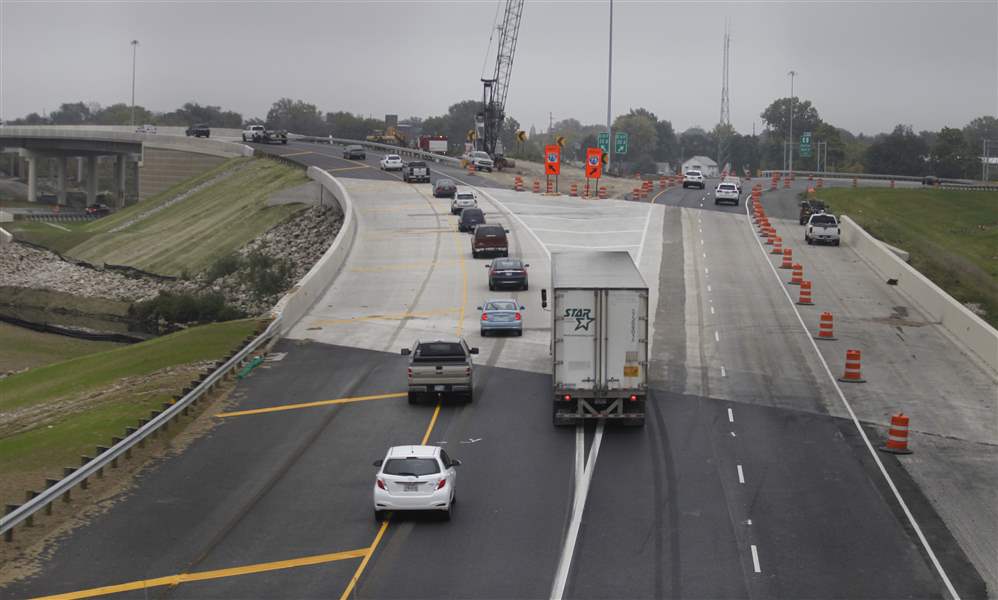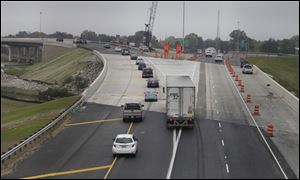
LONG-TERM PLANS
14th Street entrance to northbound I-75 studied
ODOT to present idea for ramp on Tuesday
12/9/2013
The I-75 north and south split in Toledo under construction. Ohio Department of Transportation planners have a fairly solid idea of how I-75 might be widened and several ramps near downtown might be changed when the freeway is rebuilt between South Avenue and Dorr Street several years from now.
The Blade/Lori King
Buy This Image

The I-75 north and south split in Toledo under construction. Ohio Department of Transportation planners have a fairly solid idea of how I-75 might be widened and several ramps near downtown might be changed when the freeway is rebuilt between South Avenue and Dorr Street several years from now.
Ohio Department of Transportation planners have a fairly solid idea of how I-75 might be widened and several ramps near downtown might be changed when the freeway is rebuilt between South Avenue and Dorr Street several years from now.
But a question is open: Should the current 14th Street entrance to northbound I-75, heavily used by commuters from West Toledo and Sylvania, be replaced with a ramp off the Anthony Wayne Trail’s north end, near Lafayette and Michigan streets?
Relocating access from downtown Toledo to northbound I-75 would simplify downtown navigation for infrequent visitors by making Michigan-to-the-Trail the route to get to I-75 in either direction.
But Michael Stormer, ODOT’s district planning engineer, acknowledged a potential drawback: Traffic that now uses 14th to cross downtown Toledo’s northwestern edge might overwhelm Michigan if the ramp were changed.
So rather than include it as a proposal, ODOT plans to present the ramp idea for discussion when it holds a meeting Tuesday to present its “preferred alternative” for rebuilding and widening I-75 between South and Dorr.
“We are going to show that [ramp relocation] as an option,” Mr. Stormer said. “We are not recommending it, but we can physically do it. ... We’re going to throw it out there and see what sticks.”
The open house is 4 to 6 p.m. at the Toledo Metropolitan Area Council of Governments offices at Dr. Martin Luther King, Jr., Plaza, off Broadway near the southern edge of downtown Toledo.
Rebuilding I-75 from Dorr to South is expected to cost $116 million and is tentatively scheduled for two years, starting in 2016, although Mr. Stormer emphasized “tentatively” because funding is not authorized.
The project’s centerpiece will be rebuilding the I-75 bridge over the Trail, Swan Creek, Collingwood Boulevard, and Erie Street, also known as the Downtown Viaduct. That work will occur in several phases, with a third lane added for through traffic in both directions and the northbound lanes shifted to the west so that they’re next to the southbound lanes, instead of being split apart.
Pushing the northbound lanes west, in turn, will create room on the east side to shift the northbound Trail’s ramp to northbound I-75, which now becomes the freeway’s left lane, so that it enters on the right-lane side.

ODOT also plans to divert the Trail’s entrance to southbound I-75 so that it merges into the right lane.
Both ramp changes are consistent with a broader ODOT campaign to eliminate left-hand freeway entrances and exits wherever practical, but shouldn’t represent significant changes for travel through the interchange.
“You’re going to do the same exact movements you’ve been doing,” just in a safer manner, Mr. Stormer said.
“The best part of this is getting a third lane through Toledo,” he said, noting that last-minute lane changes at I-75’s downtown exits are a recurring cause for crashes.
Besides the ramp changes, the conceptual plan also shows the northbound Trail tying in to Vance Street to reach Erie, rather than at the Erie-Lafayette intersection. Mr. Stormer said that is shown to accommodate a city of Toledo “Gateway Project” proposal to revamp traffic patterns in the Erie-Lafayette area, but the Trail approach to Erie could be changed to fit whatever city officials decide to do there.
To accommodate freeway widening, the Nebraska Avenue and Indiana Avenue bridges over I-75 will be replaced during the project, while the Dorr Street bridge is to be rebuilt during the reconstruction between Dorr and Detroit, Mr. Stormer said.
The Dorr-to-South project is just part of a heavy menu of I-75 reconstruction that ODOT plans during the next six to seven years.
First up is a $19 million project between Dorr and Central Avenues that is mostly rebuilding existing pavement, with a bit of widening at the I-475 junction. It’s expected to be done by November, 2015.
In March, 2015, ODOT plans to start rebuilding and widening I-75 between Detroit Avenue and I-280, with the section south of Lagrange Street taking three or four years and the section north of Lagrange taking two. The combined cost is budgeted at $208 million.
More tentative, meanwhile, is the construction schedule for rebuilding the freeway between South Avenue and Glenwood Road in Rossford, which will include modernizing the DiSalle Bridge. Mr. Stormer said that three-year, $200 million project also awaits full funding, but could start in 2017.
ODOT officials expect to maintain two lanes in each direction on I-75 during all of the projects, but “there will be some things we’re going to have to work on with ramps and ramp closures,” Mr. Stormer said.
Separate from all the I-75 work through Toledo is a multiphase widening campaign to start next year between Perrysburg and Findlay. Funding for that work and several stages of the work closer to Toledo will come from a $1 billion Ohio Turnpike bond issue, but the Dorr-to-South project will be paid for with traditional ODOT money because it doesn’t expand capacity enough to qualify for turnpike financing, Mr. Stormer said.
Contact David Patch at: dpatch@theblade.com or 419-724-6094.